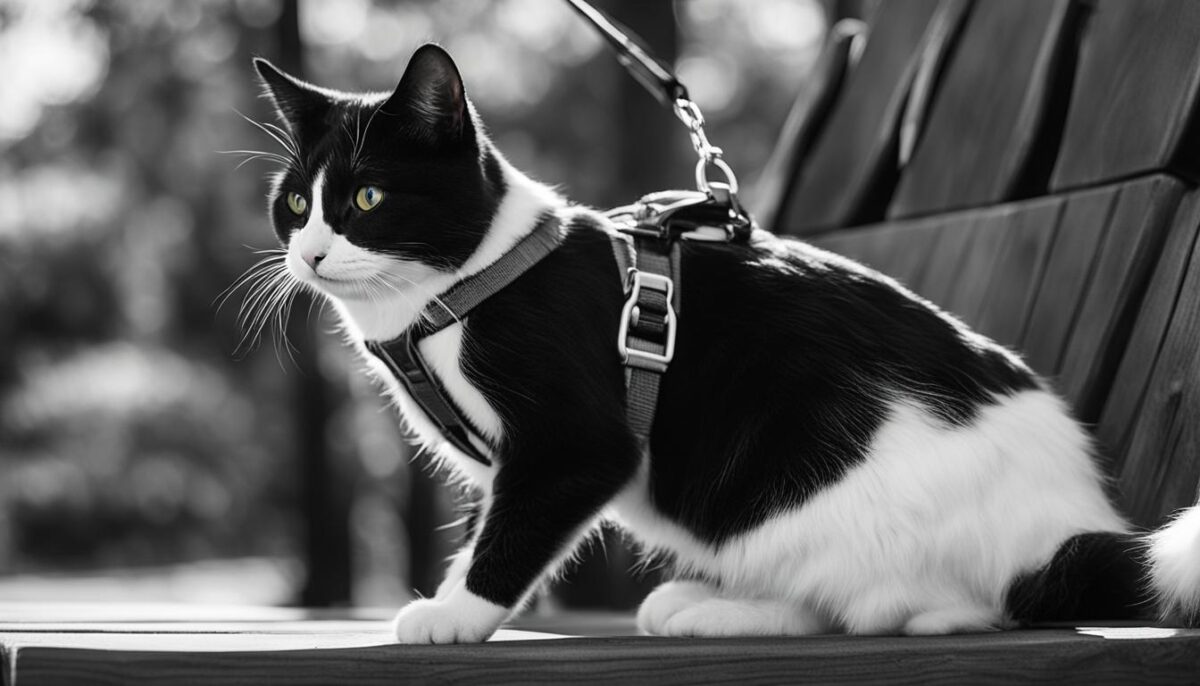Did you know your furry friend can help others feel better? It’s true! Cats like yours can give comfort and joy to people who are sick or sad. This is called feline-assisted therapy, and it’s a part of animal-assisted therapy. But for your cat to do this, you both need to learn how. This means going through pet therapy training and getting a cat therapy certification.
To start, you’ll see if your cat likes to be around new people and places. If so, great! You can teach your cat to be calm and friendly everywhere. That includes hospitals, schools, and old folks’ homes. You’ll help your cat get used to a lot of things, like being in a carrier and walking with a leash. And if you both do well, you can become a super team ready to spread happiness.
Key Takeaways
- Your cat can bring joy to others by becoming a therapy cat.
- Getting your cat ready involves training and getting a special certificate.
- Your cat should like meeting new people and not be scared in new places.
- You will teach your cat to be chill with a carrier and walking on a leash.
- If you both learn well, you can be a certified team to help others feel better.
Starting Early: Socializing Your Future Therapy Cat
If you dream of your kitten becoming a helper to those in need, starting early with kitten socialization is key. This is how your furry friend will learn to be calm and happy around all sorts of people and places. Like learning the ABCs, early cat training is the alphabet for a future therapy cat’s education.
Understanding the Importance of Early Socialization
When kittens meet lots of people and experience new things in a kind and gentle way, they grow up to be brave and loving. Think of it as the kitten’s first school, where they learn to trust and not be scared of new friends or places. This is the first big step in therapy kitten preparation.
Progressive Socialization Approaches in the Home Environment
Let’s make learning fun for kittens at home! Petting your kitten all over, playing with paws and tail, but taking a break if they seem scared. It helps them feel safe and learn that being touched is a good thing. Just like people, kittens need breaks too, so let’s make sure they have plenty of time to relax.
Introducing Your Kitten to Strangers and Other Animals
Bringing new people into your home and letting your kitten say ‘hello’ first helps them make new friends. It’s like having a playdate, but for kittens! They’ll learn that visitors are friends, not scary at all. And taking your kitten for car rides and visits means they won’t just think cars lead to the vet. Instead, car rides can be the start of a fun adventure!
Foundation Training: Clicker and Basic Commands
Are you ready to start a fun part of training with your cat? Clicker training for cats is cool! It’s like a game where every time they do something good, they hear a click and get a yummy treat. This helps your cat learn basic obedience commands.
Let’s begin with clicker training. It’s a way of teaching that uses positive reinforcement training. First, your cat hears a click, then you give them a treat. They will think, “I did something right!” and will want to do it again. So, if you ask your cat to “sit” and they do, click and treat! Soon, they’ll know that “sit” means to put their little bottom on the floor.
How about teaching your cat to come when you say their name? It’s easy. Every time they come to you, you say their name, and then you give them a treat and say “Good kitty!” Cats are smart, and they’ll soon get it.
Now, for the “stay” command. It might be a bit tricky, but you can do it. With your cat sitting still, say “stay,” and if they don’t move, it’s click and treat time! Start easy, but you can slowly move around a little to make it more fun for both of you.
Remember, training takes time, and every cat learns at their own pace. You need to be patient and keep the training fun. Before you know it, your cat will amaze you with their new skills!
- Start with a clicker and treats
- Teach them to “sit” using treats
- “Come” when their name is called
- Use clicker for “stay” command
- Be patient and have fun!
Leash Training and Acclimating Your Cat to Various Environments
Teaching your cat to walk with a leash is a big step! It’s not only useful, but it can be fun. Before heading outside, you want your cat to feel happy and safe wearing a harness. Start inside your house where your cat feels at home. Put the harness on for short times and give your cat treats to make it a fun game. Now, are you ready for some fresh air?
Introducing Your Cat to a Harness
When you introduce your cat to a harness, do it slowly. Let your cat sniff the harness first, and then try putting it on for just a little bit. Give your cat a treat when they wear the harness without fussing. This tells your cat that the harness means good things are coming!
From the Backyard to the Neighborhood: Outdoor Acclimation
Once your cat is okay with the harness, you can start exploring! Let your cat walk around the backyard while on the leash. Keep holding onto the leash – it’s to make sure your cat stays safe. Over time, as your cat gets braver, you can take short walks around where you live. This helps your cat get used to new sights, smells, and sounds. And don’t forget: making sure your cat likes their carrier is super important too. A comfy carrier means your cat can travel to places safely.
Remember, slow and steady wins the race. With patience and practice, your cat can learn to love the harness and enjoy adventures with you!
Is Your Cat Cut Out for Therapy Work?
Wondering if your furry friend has what it takes to be a therapy cat? Not every cat has the therapy cat temperament needed for this important job. Cats that are suitable for therapy love being around people and stay chill in new spots. They love getting pets and cuddles from anyone they meet! It’s not just about being cute; it’s how they act that matters.
If you want to start assessing your cat’s potential for therapy, watch how they behave around new folks and in new places. Are they curious and friendly, or do they hide under the bed? The best therapy cats aren’t scaredy-cats. They’re the ones who want to say hello to every visitor and don’t get upset by new noises or smells.
Here’s a cool idea: play a “Can You Be A Therapy Cat?” game with your cat. Try these steps to see if they might like the job:
- Invite a friend over and see if your cat goes to say hi.
- Play dress-up in hats or sunglasses to see if your cat still recognizes and approaches you.
- Try new games and toys to check if your cat is up for new fun.
Remember, if your kitty loves the attention and stays cool with the new games, they might just be a purr-fect fit for therapy work! If your cat prefers a quiet nap in the sun, that’s okay too. There are lots of ways to be a great cat without being a therapy cat.
Finally, here is a picture of a cat just being super chill, which is just like the kind of cat that makes a great therapy companion.
If your cat passes the test with flying colors, they might be ready to train for becoming a therapy cat. So go ahead, give it a try and see if your cat has the fluffy charm and chill vibe to brighten someone’s day!
Therapy Cat Training Certification: Navigating the Process
When you think about having a furry friend that can help others, getting your cat certified for therapy work is a great place to start. Just like people, cats need to learn how to be the best they can be. This means making sure they are old enough, have spent enough time with you, and understand how to be calm and kind with different people. It’s a journey you both will take that brings smiles to others and joy to your hearts.
Criteria for Selecting a Therapy Cat
Your cat is special, but to be a therapy cat, there are a few boxes to check. Your cat should be at least one year old and have been living with you for six months. This helps make sure your cat feels safe with you as they meet new friends. Remember, the best therapy cat is healthy, friendly, and doesn’t get scared easily in new places.
Completing a Handler’s Course
You also get to learn some cool stuff with handler training courses. There are special online classes where you can learn how to help your cat be the best therapy cat out there. These classes teach you about feline behavior, how to help your cat deal with different places, and ways to keep them happy and healthy to do their best work.
Health Checkups and Dietary Considerations
Your cat’s health is very important, not just for them, but for the people they will help. They need up-to-date shots and checkups to make sure they’re in tip-top shape. Also, they cannot eat raw proteins like sushi; we don’t want to share any bad germs, right? The feline health requirements for therapy work are all about keeping everyone, including your purry friend, safe and sound.
After checking all these things off your list and with a vet’s thumbs up, you’re almost there. You fill out some paperwork, pay a fee, and just like that—your cat is ready to take on the world and bring smiles everywhere they go. So, get ready to make a difference with your fluffy sidekick. With your love and a little bit of training, your cat will be a super therapy hero!
Conclusion
Therapy cats are special friends who bring joy and peace to people who need it. When you finish the steps for your cat to become a therapy cat, they can give emotional support safely. A cat with a friendly nature and a patient owner can do this important job. By helping your cat learn and get used to new places, you both work toward becoming a team that makes others happy.
Remember, the benefits of therapy cats are big. They help folks feel less alone and more at ease. If your cat likes people and is calm, you could train them to be good at this. It takes time to train and understand your cat, but in the end, you can help many people together.
So, by completing cat therapy training, your cat can be ready to offer love and comfort to people who need it. And that’s a wonderful thing you and your kitty can do for others. It’s about sharing kindness and making a difference. That’s what makes therapy cats so great.
FAQ
What is therapy cat training, and how does it differ from service animal training?
Therapy cat training involves teaching your cat to provide comfort and emotional support to individuals in various settings, like hospitals or nursing homes. Unlike service animals that perform specific tasks for people with disabilities, therapy cats offer psychological and emotional support through their presence and interactions.
Why is early socialization important for therapy kittens?
Early socialization is crucial for therapy kittens as it helps them become comfortable with handling, interaction with strangers, and adapting to new environments. This prepares them for their future role as a therapy cat, making them sociable and calm in various settings.
What are the foundational commands taught during therapy cat training?
The foundational commands include “sit,” “stay,” and responding to their name. These are typically taught using positive reinforcement and clicker training to create a positive association between the command, the action, and a reward.
How do I introduce my cat to a harness for leash training?
Start by introducing your cat to a harness indoors, allowing them to wear it for short periods to get accustomed. You can then gradually progress to secured outdoor areas like a backyard, increasing exposure and comfort before attempting walks in more public spaces.
How can I tell if my cat has the right temperament for therapy work?
A cat suitable for therapy work should be sociable, enjoy receiving attention, and remain calm in new or different situations. They should not exhibit shy, skittish, or aggressive behaviors, but instead, be relaxed and adaptable to various environments.
What criteria must be met for a cat to become certified for therapy work?
The criteria include the cat being at least one year old, living with their handler for a minimum of six months, being in good health and up-to-date on vaccinations, and not being on a raw protein diet. Handlers must also complete a training course on proper handling and preparing their cat for therapy work.
Are there any health considerations I need to be aware of before my cat can start therapy work?
Yes, your cat must be in overall good health, with regular checkups and vaccinations. It’s also essential to ensure they are not on a raw protein diet to minimize the risk of bacterial transmission during therapy visits.
What is the role of a therapy cat in animal-assisted therapy?
In animal-assisted therapy, a therapy cat provides comfort, stress relief, and emotional support to individuals. Their presence can help improve mental health, reduce anxiety and loneliness, and promote a sense of well-being in therapeutic settings.


